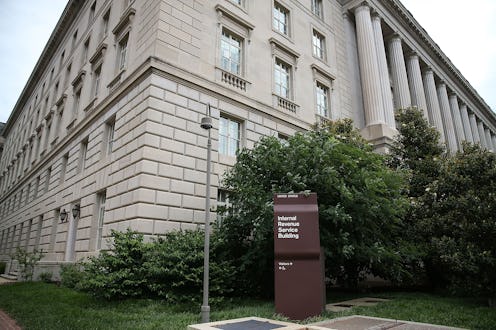News
This New Tax Deduction Cap Is Already Dealing A Blow To Millions Of People's Refunds

As Tax Day approaches, many people are in the process of filing their returns — and some are encountering surprising changes as a result of 2017's tax reform legislation. Notably, one of these changes is a limit on the state and local tax (SALT) deduction. As you're filing taxes, you may be wondering how the SALT deduction works and how tax refunds could be impacted by this change. As it turns out, those in high-tax locations are most likely to face higher tax bills because of the cap.
As CNN reported, the Tax Cuts and Jobs Act was signed into law in December 2017. The SALT cap, which prohibits individuals from deducting more than $10,000 in state and local taxes from their federal income taxes, was established as part of this law, CNN added. Now, as taxpayers are filing their taxes with these new tax reform measures in place, some are seeing firsthand the impact of this cap.
As Bloomberg revealed, a report released on Tuesday by the Treasury Inspector General for Tax Administration revealed that, so far, there's about $323 billion in state and local taxes that taxpayers can no longer deduct on their federal tax returns. The cap has affected almost 11 million people, the outlet noted.
Bloomberg added that, as a result of this cap plus other tax reform changes that resulted in different withholdings in 2018, some people are likely receiving smaller refunds. However, the New York Times noted that other tax reform initiatives, like the doubling of the standard deduction and the removal of the alternative minimum tax, may help offset any tax increases caused by the SALT cap.
The paper also noted that the cap is most likely to affect those living in high-tax (and typically left-leaning) cities and states, like New York and California. It also added that the nonpartisan Tax Policy Center found that the individuals most likely to be affected by the SALT cap are frequently among the top one percent of income earners.
Because of the SALT cap's disproportionate impact on high-tax cities and states, some government officials in these locations have appealed to the Trump administration to reconsider the cap. For example, MarketWatch reported that New York's Governor Andrew Cuomo met with President Trump on Feb. 12 to urge him to rethink the cap. The outlet noted that Cuomo believes the cap is causing wealthy citizens to leave New York and causing the state to lose money.
Bloomberg reported on Feb. 7 that Trump has previously said he's "open to talking about" revising the SALT cap. The Stamford Advocate noted he told reporters on that day that “There are some people from New York who have been speaking to me about ... changing things. It’s been severe on them." Following his meeting with Cuomo on Feb. 12, the White House's deputy press secretary said via MarketWatch that "the president listened to the governor’s concerns regarding SALT."
While Trump perhaps seems open to making changes to the SALT cap, Senate Finance Committee Chairman Charles Grassley has said that Congress won't reconsider the issue. “The Senate Finance Committee won’t be revisiting the SALT deduction reforms made in the Tax Cuts and Jobs Act ...," Grassley's spokesman, Michael Zona, told CNBC on Feb. 7.
As Bloomberg noted, the cap was initially put in place to help offset tax cuts included in 2017's tax reform legislation. The outlet said that, according to the Tax Foundation, a conservative-leaning nonprofit, removing the cap would cost about $673 billion in a ten-year period. Several bills have already been introduced in Congress to repeal the cap, Bloomberg revealed.